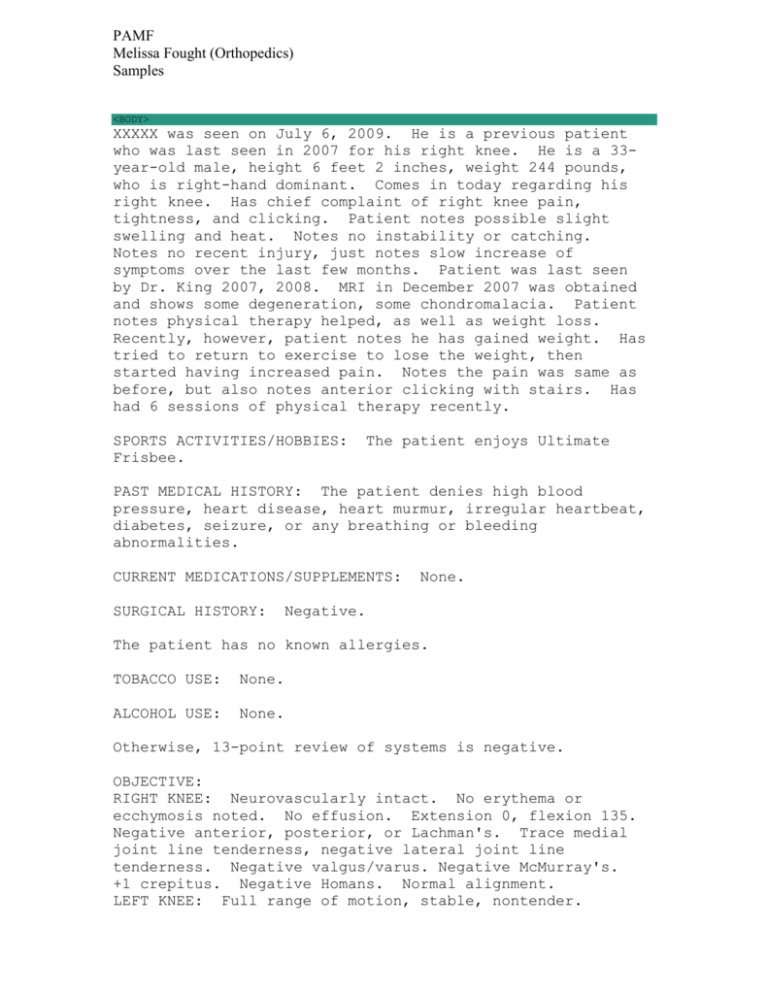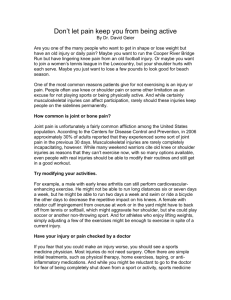5 - Acusis
advertisement

PAMF Melissa Fought (Orthopedics) Samples <BODY> XXXXX was seen on July 6, 2009. He is a previous patient who was last seen in 2007 for his right knee. He is a 33year-old male, height 6 feet 2 inches, weight 244 pounds, who is right-hand dominant. Comes in today regarding his right knee. Has chief complaint of right knee pain, tightness, and clicking. Patient notes possible slight swelling and heat. Notes no instability or catching. Notes no recent injury, just notes slow increase of symptoms over the last few months. Patient was last seen by Dr. King 2007, 2008. MRI in December 2007 was obtained and shows some degeneration, some chondromalacia. Patient notes physical therapy helped, as well as weight loss. Recently, however, patient notes he has gained weight. Has tried to return to exercise to lose the weight, then started having increased pain. Notes the pain was same as before, but also notes anterior clicking with stairs. Has had 6 sessions of physical therapy recently. SPORTS ACTIVITIES/HOBBIES: Frisbee. The patient enjoys Ultimate PAST MEDICAL HISTORY: The patient denies high blood pressure, heart disease, heart murmur, irregular heartbeat, diabetes, seizure, or any breathing or bleeding abnormalities. CURRENT MEDICATIONS/SUPPLEMENTS: SURGICAL HISTORY: None. Negative. The patient has no known allergies. TOBACCO USE: None. ALCOHOL USE: None. Otherwise, 13-point review of systems is negative. OBJECTIVE: RIGHT KNEE: Neurovascularly intact. No erythema or ecchymosis noted. No effusion. Extension 0, flexion 135. Negative anterior, posterior, or Lachman's. Trace medial joint line tenderness, negative lateral joint line tenderness. Negative valgus/varus. Negative McMurray's. +1 crepitus. Negative Homans. Normal alignment. LEFT KNEE: Full range of motion, stable, nontender. MRI of the right knee from December 2007 was again reviewed with the patient. It shows some small flap tear of cartilage patellar keel, degeneration medial meniscus. ASSESSMENT: Right knee chondromalacia. PLAN: Options were extensively discussed with the patient. The patient was instructed on rehabilitation, strengthening, modification of strengthening, weight loss. Brochures and instructions were given to the patient. Also a prescription for physical therapy was given to the patient. He will follow up with us if he has any increasing, worsening symptoms or concerns or failure to improve in 6 weeks. </BODY> <BODY> OBJECTIVE: Right shoulder neurovascularly intact. No erythema or ecchymosis is noted. Forward elevation 170, internal rotation at 90 is 90, external rotation at 90 is 90. Right shoulder strength: Supraspinatus external rotation, internal rotation, biceps, triceps is 5 out of 5. Negative Neer, positive Hawkins, +1 O'Brien, negative cross-body. AC nontender. Left shoulder full range of motion, strength 5 out of 5. ASSESSMENT: Right shoulder impingement syndrome. PLAN: Options were discussed. Activity was discussed. Patient was given a script for physical therapy. Instructions and brochures were given to the patient. Was instructed on antiinflammatories, rotator cuff exercises. We will hold on injection at this point. Follow up with us in 4 weeks if she continues with symptoms. Knows she can call with questions or concerns. </BODY> <BODY> XXXXX was seen in conjunction with Dr. King June 30, 2009. Comes in today regarding his left knee. Has a chief complaint of left knee looseness, center of the knee soreness and posterior swelling. Has had previous ACL reconstruction with allograft March 1998 by Dr. Ting. Comes in today after a new left knee MRI. Left knee neurovascularly intact. No erythema or ecchymosis noted. Trace effusion. Range of motion 135 to 0. Negative anterior and posterior Lachman. Negative medial and lateral joint line tenderness. Negative valgus/varus. Trace crepitus. Negative Homans. MRI of the left knee shows a small effusion and lateral femoral condyle chondromalacia with subchondral edema, femoral trochlea chondromalacia, intact ACL graft. ASSESSMENT: Left knee chondromalacia, lateral femoral condyle and femoral trochlea status post ACL reconstruction, with intact graft. PLAN: Options were discussed. At this time we are recommending nonsurgical treatment. He was instructed on rehabilitation, strengthening. Activity was discussed. He will follow up with us on an as-needed basis. </BODY> <BODY> XXXXX was seen on July 2, 2009, comes in today regarding his right knee. Status post scope, partial lateral meniscectomy, abrasion femoral trochlea, chondroplasty patella, ACL reconstruction with allograft June 17, 2009. SUBJECTIVE: Patient notes he is doing well in terms of his knee, has been performing his home rehabilitations, wearing his brace, feels overall improvement in strength and stability. Notes he would feel confident without using his brace at this point. Has been doing home rehabilitation including biking and strengthening. Patient also comes in regarding his right shoulder, received AC injection June 8, 2009. Noted improvement after that injection would like to proceed with a subacromial space injection. Previously diagnosed with right shoulder impingement, chronic second-degree AC separation. OBJECTIVE: Right knee neurovascularly intact. No erythema or ecchymosis noted. Incisions clean, dry, intact, and healing. +1 effusion, range of motion 100 to 0. Negative Homans. Negative anterior or posterior Lachman’s. Right shoulder full range of motion, strength 5/5. +1 Neer. +1 Hawkins. ASSESSMENT: 1. Right knee status post scope, partial lateral meniscectomy abrasion, femoral trochlea, chondroplasty patella, ACL reconstruction with allograft. No obvious postop complications. 2. Right shoulder impingement syndrome, chronic AC separation. PLAN: Options were discussed. Patient was instructed on continuation of rehabilitation of right knee and extensive discussion was undertaken with the patient demonstrating rehabilitation exercises. Again, he feels confident on doing rehab on his own. Also notes he would like to proceed with right shoulder subacromial space injection. After sterile preparation, was injected in right shoulder subacromial space with 1 cc of Kenalog mixed with 1 percent lidocaine. After the injection the patient notes overall improvement. Was instructed on continued modification of activities, rehabilitation for the knee and shoulder. Will follow up with us in 4 weeks. </BODY> <BODY> XXXXX was seen on July 9, 2009. Comes in today for followup of his right knee. Was previously diagnosed with a right knee osteoarthritis greatest at the lateral compartment. Was last seen June 25, 2009 in conjunction with Dr. King. At that time xrays were reviewed. Patient received his 1st injection of Hyalgan. Since then has been participating in extensive yoga. Notes that his knee feels slightly unstable and has a small amount of swelling. Notes stiffness first thing in the morning. Notes no change after the 1st injection. Patient has had these feelings of instability occasionally before. Notes no gross buckling. OBJECTIVE: Right knee neurovascularly intact. No erythema, ecchymosis is noted. +1 effusion. Extension 0, flexion 135. lateral joint line tenderness. Trace medial joint line tenderness. Positive crepitus. Negative anterior drawer, posterior drawer, Lachman. Negative Homans. +1 ASSESSMENT: Right knee osteoarthritis greatest at lateral compartment. PLAN: Options were discussed. At this time patient notes he would like to proceed with Hyalgan injection number 2. After sterile preparation was injected into the right knee intraarticular space with 2 mL of Hyalgan. Patient was instructed on modification of activities in the next 24 hours and modification of activities based on symptoms, avoiding full flexion, deep knee bends and yoga. Will follow up with us in 1 week. </BODY> <BODY> XXXXX was seen in conjunction with Dr. King July 2, 2009. Bryan is a new patient. 46year-old male, height 6 feet 4 inches, weight 237 pounds, occupation construction, who is right-hand dominant. Comes in today regarding his left knee. Has a chief complaint of left knee soreness, lateral shooting pain. Notes he is not able to fully extend his knee for the last few months. Does not recall a specific injury. The patient was seen and evaluated by Dr. Eric Weirich, Los Altos PAMF, who prescribed Celebrex. The patient has been taking Celebrex 200 mg q. day, after which he notes improvement. SPORTS ACTIVITIES/HOBBIES: The patient enjoys woodworking. PAST MEDICAL HISTORY: The patient denies blood pressure, heart disease, heart murmur, irregular heartbeat, diabetes, seizure, or any breathing or bleeding abnormalities. CURRENT MEDICATIONS/SUPPLEMENTS: Positive for Celebrex, Reglan, and simvastatin. SURGICAL HISTORY: Negative. The patient has no known allergies. TOBACCO USE: 1 pack a day. ALCOHOL USE: None. Otherwise, 13-point review of systems for the patient is negative. OBJECTIVE: Left knee: left knee neurovascularly intact. No erythema, ecchymosis noted. +1 effusion.. Range of motion 130, minus 5 degrees, negative anterior posterior, Lachman's, trace medial joint line tenderness, negative lateral joint line tenderness. Negative valgus/varus, negative Homans. Right knee: range of motion 135 to 0. MRI: of the left knee was reviewed with the patient and showed lateral femoral condyle signal, possible spontaneous osteonecrosis of the knee (SONK) with chondromalacia, patella. ASSESSMENT: Left knee: spontaneous osteonecrosis of the knee PLAN: Options and diagnosis were discussed. Activity was discussed. .The patient was instructed on pain-free activities. He can walk straight legged without area coming into contact. He was instructed on modification of activities and weightbearing. He was given the okay to walk straight legged. The patient will follow up with us in 6 weeks. </BODY> <BODY> OBJECTIVE: Right shoulder neurovascularly intact. No erythema or ecchymosis noted. Active forward elevation to 120. Internal rotation 95, external rotation at zero is 45. Right shoulder strength supraspinatus external rotation, internal rotation of biceps and triceps of 5 out of 5. +1 Neer. +1 Hawkins. +2 tenderness over the AC joint. Positive effusion noted over the AC joint. X-rays that were obtained in urgent care were reviewed with the patient. Dr. Eakin was brought in for consultation. Discussed a possible AC injection. ASSESSMENT: Right shoulder first degree AC separation. PLAN: Options were discussed. The patient was instructed on activity modification, anti-inflammatories, and ice. Prescription for Vicodin was given to the patient as well as ibuprofen was also discussed. Activity modifications. Slow progressive range of motion. Rehabilitation was discussed. The patient will followup with us. If he fails to improve notes he can call with questions or concerns. </BODY> <BODY> XXXXX was seen on June 6, 2009. Comes in today regarding her right shoulder. Previously diagnosed with right shoulder impingement status post scope, acromioplasty, bursectomy, debridement labrum July 1, 2009. SUBJECTIVE: The patient notes that she is doing well. She is wearing her sling. Taking Darvocet p.r.n. night pain and Motrin for daytime pain. Using ice. OBJECTIVE: Right shoulder neurovascularly intact. No erythema or ecchymosis. Incision clean, dry, and intact. Elbow full range of motion. ASSESSMENT: Right shoulder impingement status post scope, acromioplasty, bursectomy, debridement labrum. No obvious postop complications. PLAN: Postoperative course was discussed. Patient instructed on Codman exercises at home to start. We are requesting physical therapy 3 times a week for the next 4 weeks. Instructions given to patient. Should be off work next 4 weeks. Followup with us in 4 weeks' time. </BODY> <BODY> The patient was seen in conjunction with Dr. King on June 29, 2009. Comes in today regarding his right shoulder. Previously diagnosed with right shoulder impingement. Had a previous MRI, received subacromial space injections May 28, 2009. Patient notes the injection helped him dramatically, however, is still having some pain, feels he is about 90 percent improved, would like a second injection today. OBJECTIVE: Right shoulder neurovascularly intact. No erythema or ecchymosis noted. Forward elevation 170, internal rotation at 90 is 90; external rotation at 90 is 90. Right shoulder strength 5/5. +1 Neer, +1 Hawkins. ASSESSMENT: Right shoulder impingement syndrome. PLAN: 1. Options were discussed. At this time, patient notes he would like to proceed with subacromial space injection. 2. After sterile preparation, was injected in the right shoulder, subacromial space, with 1 cc Kenalog mixed with 1 percent lidocaine. After the injection, patient was instructed on modification of activities, rehabilitation. Gym program was discussed. Will follow up with us in 1 month if he continues with symptoms. Knows he can call for questions or concerns. </BODY>





